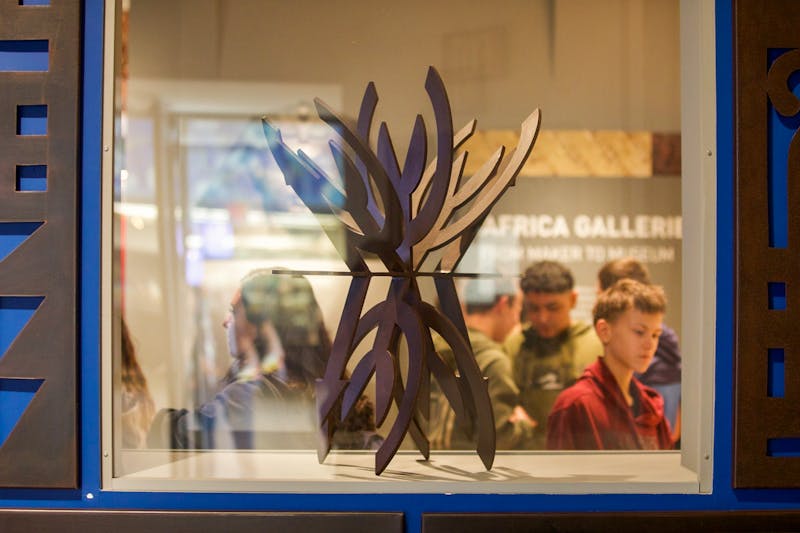
"Hostile Terrain 94" is a 20-foot-long map of the Arizona-Mexico border filled with identification tags of those who died trying to migrate to the United States.
Credit: Maria MuradPenn Museum is hosting an interactive pop-up art installation this week to commemorate over 3,000 migrant lives lost at the border between Arizona and Mexico.
The exhibit, titled "Hostile Terrain 94," is a 20-foot-long map of the Arizona-Mexico border filled with identification tags of those who died trying to migrate to the United States. Volunteers from the Penn community and the general public were asked to help assemble the project, which was coordinated by the Penn Museum and the Wolf Humanities Center Forum on Kinship.
On Monday and Tuesday, volunteers filled the Penn Museum to write identification tags for each of the more than 3,000 people who died. Each tag included a name (if known), case number, age, sex, date the body was located, condition of the body, cause of death, and the coordinates of where remains were found. Exhibit coordinators then placed the tags on the map in their respective coordinates, creating a visual depiction of just how many people died seeking a new life in the United States.

Each tag, filled out by volunteers, included a name (if known), case number, age, sex, date the body was located, condition of the body, cause of death, and the coordinates of where remains were found.
“You see the tags hanging on the wall, but it doesn’t really hit you until you start writing them," exhibit volunteer and 1990 College graduate Deena Schuman said. "Each one of the tags represents a real human being who suffered so much that they were willing to die to get here.”
Another volunteer, 1996 College graduate Jacqueline Silverman, said it was "heart-wrenching" to read the tags' brutal descriptions of causes of death, ranging from gunshot wounds to lacerations and hangings.
The exhibit was created by Jason De León, a professor of anthropology and Chicano/a studies at the University of California, Los Angeles. De León is also director of the Undocumented Migration Project, which uses ethnography, archaeology, visual anthropology, and forensic science to study covert migration between Latin America and the United States.
Gabe Canter, an exhibit coordinator who works with De León, said the name "Hostile Terrain 94" references a Clinton-era border control strategy called "Prevention Through Deterrence." This approach, adopted in 1994, blocked urban entry points and led migrants to try crossing the border in the extreme heat and dryness of the Arizona desert, which was known as the "hostile terrain."

Jason De León and exhibition coordinators Gabe Canter and Nicole Smith answered questions from audience members in the Penn Museum Wednesday about de León's art installation "Hostile Terrain 94" and ethnography "The Land of Open Graves."
Canter added that "Hostile Terrain 94" was first exhibited last January at Franklin and Marshall College in Lancaster. While the popup began as a series of red dots on a wall, it was ultimately reimagined to be a series of tags scattered across the wall, giving the project a more personal feel. Canter added that the pop-up is anticipated to spread to 150 additional locations across the world throughout the next year, leading up to the presidential election in 2020.
"We didn’t expect it to be easy, but we were surprised by how heavy, truly, just the task of filling out the tags was," Canter said of his experience assembling the exhibit. "I’ve done this four times and it still hits me in different ways at different times."
The exhibit will remain at the Penn Museum until Friday, Sept. 27. De León will also give a lecture at the Lightbox Film Center on Wednesday, followed by a screening of "Border South," a film he was involved in.
Canter was impressed by the number of volunteers who showed up at Penn to put the exhibit together.
"Everyone here has been pretty amazing," Canter said. "We had people staying for hours and hours."
The Daily Pennsylvanian is an independent, student-run newspaper. Please consider making a donation to support the coverage that shapes the University. Your generosity ensures a future of strong journalism at Penn.
Donate






